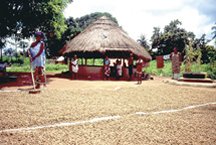African peanut farmers can slash their exposure to a class of harmful fungal toxins by adopting several simple measures after the harvest, researchers have shown. In many developing countries, the carcinogenic contaminants called aflatoxins are abundant in subsistence crops, including peanuts and cereals.

Peanuts become tainted with aflatoxins during storage under hot, moist conditions that promote fungal growth. Insects feeding on the stored peanuts spread the aflatoxin-producing soil fungi and damage the shells that protect the edible kernels.
Aflatoxins, which withstand cooking, occasionally cause rapid, deadly poisonings in people who have eaten heavily contaminated foods. Smaller, repeated doses gradually elevate the risk of liver cancer and, in children, impair growth and immune function.
“These are foods people eat every day, so exposure is very high and chronic,” says molecular epidemiologist Chris Wild of the University of Leeds in the United Kingdom. In western Africa, for example, nearly all people show evidence of aflatoxin exposure in their blood. In developed countries, advanced processing methods and stringent food testing make exposure less common.
To minimize aflatoxins in stored peanuts, Wild and his colleagues advocate a suite of farming practices. These include hand sorting peanuts and discarding visibly moldy or damaged ones; sun drying the peanuts on fiber mats rather than directly on the ground to reduce contact with ground moisture; storing peanuts in sacks made from breathable natural fibers rather than moisture-retaining plastic; storing the sacks on wooden pallets to avoid contact with the ground; and treating the ground beneath the pallets with insecticide.
“These are things people do already, but in a fairly patchy manner,” Wild says. With the help of government workers in Guinea, in western Africa, the researchers encouraged 300 subsistence peanut farmers in 10 villages to use all the methods. The team bought pallets, mats, sacks, and insecticide for those farmers, spending about $50 per family. Nearby villages, where 300 peanut farmers employed none or only some of the storage techniques, provided a comparison group.
Blood samples taken from the farmers 5 months after the harvest indicate that those assigned to use the improved storage methods had only 43 percent as much aflatoxin exposure as the others did, Wild and his team report in the June 4 Lancet.
“This is an important demonstration that a lot can be accomplished by some rudimentary improvements in storage conditions,” says Gerald N. Wogan of the Massachusetts Institute of Technology, who has studied aflatoxins’ carcinogenic properties since the 1960s.
Some subsistence farmers sell any surplus peanuts for export, notes toxicologist John Groopman of Johns Hopkins University in Baltimore, who shares a U.S. government research grant with Wild’s team. “Being able to produce a higher-quality peanut with very little aflatoxin contamination means that farmers will be able to get a higher price for their crop,” he says.






